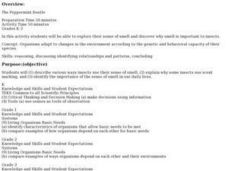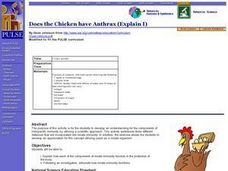Curated OER
Studying Birds in the Field
This is a well-designed science activity which helps young scholars learn the behavior of different species of birds. Working with partners and in small team, students learn to scientifically observe birds.
Curated OER
Gene Action and Mutation
Students review terms related to DNA structure and function. They complete a variety of worksheets in small groups or in pairs reflecting the unit's concepts regarding DNA. They submit their worksheets for grading.
Curated OER
How Things Go Wrong
Students identify where mutations might occur and examine what effect those mutations will have through class discussion of DNA replication and cell division. Students then differentiate between mutations that affect individuals and...
Curated OER
Protein Synthesis and Words
Learners explain the roles of mRNA, tRNA and ribosomes. They explain how mutations can occur in an individual. Students simulate parts of a cell to access about the process of protein synthesis.
Curated OER
What is Biotechnology
Young scholars discover the concept of biotechnology. For this biotechnology lesson, students explore the history of biotechnology and its implications today.
Curated OER
A Cell Is Like A City
Students create analogies that help them remember the cell parts as well as their respective functions.
Curated OER
Candy Dish Selection
Students explore natural selection. They explore the concepts of adaptations, and the way which random factors affect the survival of individuals and populations.
Curated OER
What is Biocomplexity?
Students dicuss different aspects of biocomplexity. They demonstrate synthesis of complex concepts by creating before and after posters expressing how the concepts of biocomplexity have ben internalized. Students define the term...
Curated OER
Ethical Decision Making in Biology
Young scholars explore a model that illustrates the spread of HIV through an adolescent population. Acting in the role of epidemiologists, students explore the dilemmas of HIV infection presented by a simulation. Young scholars produce a...
Curated OER
The Peppermint Beetle
Students describe various ways insects use their sense of smell, and examine why some insects use scent marking. They conduct a scent hunt, searching for a particular scent on the trees on school grounds.
Curated OER
Struggle for Existence and Population Growth in Aphids
Students examine the population of aphids. They identify adaptations they have made for their environment. They make predictions, test their hypothesis and collect information that either proves or disproves their theory.
Curated OER
Does the Chicken have Anthrax (Explain I)
Young scholars explain how each of the components of innate immunity function in the protection of the body. Following an investigation, they articulate how innate immunity functions.
Curated OER
Characteristics of Living Things
Seventh graders identify the characteristics of living and non-living things. For this biology lesson, 7th graders define vocabulary words as they go through the lesson. They answer a crossword puzzle after class discussion.
PBS
Now With Bill Moyers: Genetically Modified Foods
Learn about genetically-engineered foods, then research and report how genetic engineering is done. Investigate the pros and cons related to genetically engineered crops, and express one's own feelings on the topic.
TeachEngineering
Teach Engineering: Introduction to Genetic Engineering and Its Applications
Students learn how engineers apply their understanding of DNA to manipulate specific genes to produce desired traits, and how engineers have used this practice to address current problems facing humanity.














